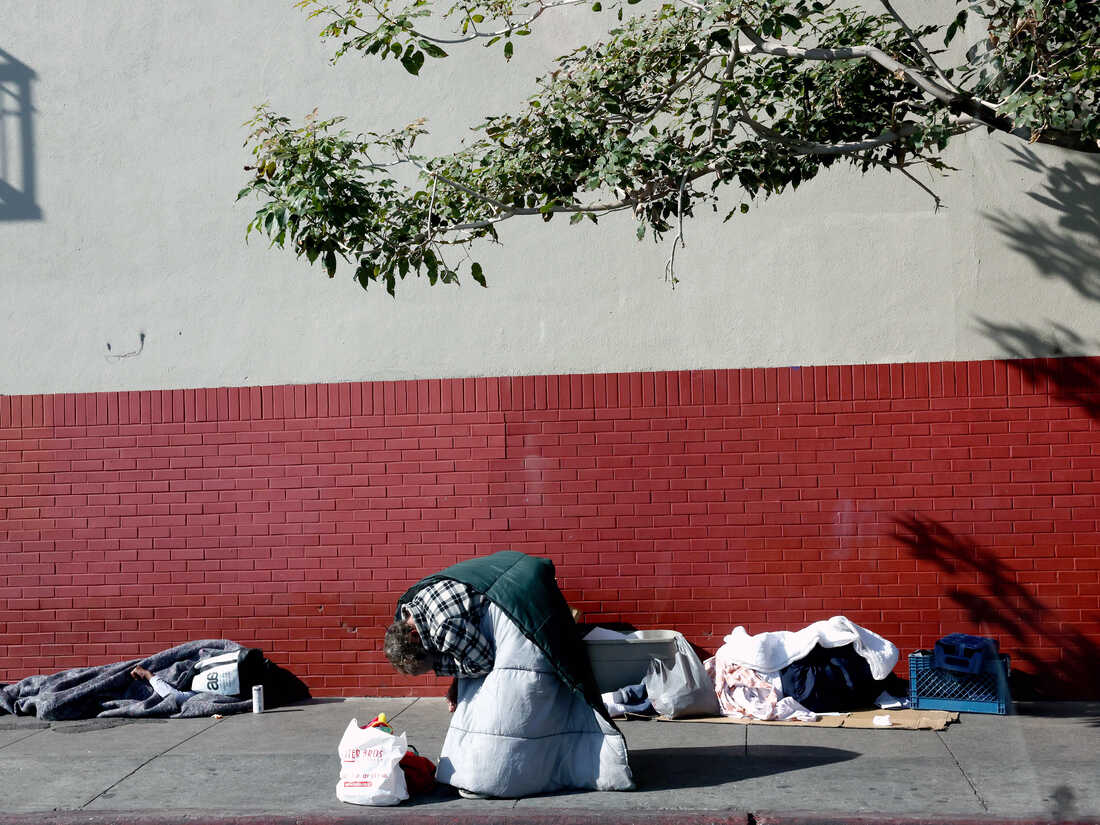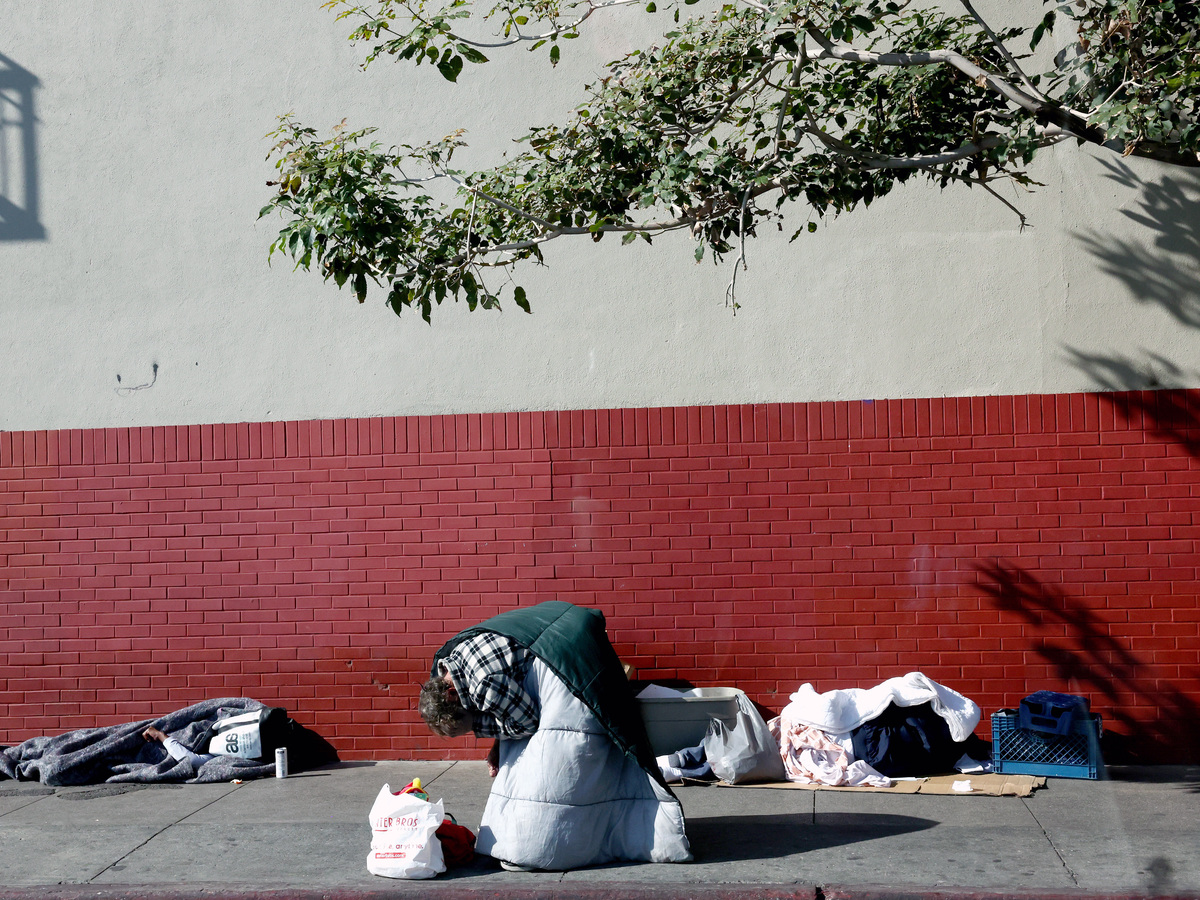

A homeless encampment along a street in Skid Row on Dec. 14, 2022 in Los Angeles, California. Two days earlier, LA Mayor Karen Bass declared a state of emergency regarding homelessness in the city, where an estimated 40,000 residents are unhoused.
Mario Tama/Getty Images
hide caption
toggle caption
Mario Tama/Getty Images

A homeless encampment along a street in Skid Row on Dec. 14, 2022 in Los Angeles, California. Two days earlier, LA Mayor Karen Bass declared a state of emergency regarding homelessness in the city, where an estimated 40,000 residents are unhoused.
Mario Tama/Getty Images
Many of Portland’s least fortunate live in tents pitched on sidewalks or in aging campers parked in small convoys behind grocery stores.
High housing costs and financial adversity are the primary root causes behind the burgeoning population on the streets; only about one in three people who are homeless in Portland report having a mental illness or a substance use disorder, or both.
But the combination of homelessness with substance use or untreated mental illnesses has led to a lot of very public tragedies.
People with schizophrenia, for example, have died of hypothermia on the city’s streets. Residents have given birth out in the open, to premature infants who did not survive. Methamphetamine, cheaper and more harmful than it used to be, is creating a heightened risk of overdose and psychosis.

Mental illness can be part of the story of how a person ends up homeless — or part of the price of survival on the streets, where sleep and safety are scarce. Unsheltered residents in Portland die thirty years earlier than the average American, according to county data.
These grim realities have ratched up the pressure on politicians to do something.
In Oregon, some politicians, including Portland mayor Ted Wheeler, have proposed changing civil commitment law, so doctors have more leeway in compelling treatment for patients who are too sick to know they need care.
Without such changes, they argue, people with untreated addictions or mental illnesses are stuck cycling between the streets, county jails, and state psychiatric hospitals.

“I think we can do better by people than allowing them to flounder,” says Janelle Bynum, a state legislator who represents suburbs east of Portland.
Bynum was the sole Democrat to sign on to a pair of bills, introduced by Republicans earlier this year, that would expand the criteria for involuntary commitment in Oregon. “My intention was to signal how cruel I think our current system is,” she says.
As multiple crises spill into streets, calls for change
Half of the country’s unsheltered people live in California, and though only about a quarter or third of them are estimated to have a serious mental illness, they are the ones residents are most likely to encounter in California’s cities. Mayors from San Francisco, San Jose, and San Diego have all expressed frustration that the threshold for psychiatric intervention is too high.
“When I’m often asked, ‘Mayor, why aren’t you doing something about this person who is screaming at the top of their lungs on the street corner? And I said, ‘Well, they’re not a threat to themselves or to others,’ that rings hollow,” says Todd Gloria, mayor of San Diego.
Now, state lawmakers in Sacramento, backed by mayors, have introduced new laws and bills that would help bring more people into treatment, even if it’s against their will.
Last year, legislators approved a new system of CARE Courts, where judges issue treatment plans. That program begins on a pilot basis this fall in eight counties, including Los Angeles and San Francisco counties, with the rest of the state expected to join next year.

This year, a bill moving through the legislature would expand who qualifies for a yearlong conservatorship, or involuntary psychiatric hold.
The bill is gathering support and sponsors are optimistic that Gov. Gavin Newsom would sign it if passed. But it’s been controversial: opponents fear a return to bygone policies of locking people up just for being sick.
Half a century ago, California policymakers shuttered state psychiatric institutions, denouncing them as inhumane. Involuntary commitment was deemphasized and state laws ensured that it only be used as a last resort. The thinking was that the patient should have autonomy and participate in their care.
But progressive leaders across California are now reconsidering involuntary commitments. They argue that not helping people who are seriously ill, and living in squalor on the streets, is inhumane. Psychiatrists who support the bill say it would constitute a modest update to a 56-year-old law.

The shift is dividing liberals over the very meaning of compassion and which rights should take precedence: civil rights like freedom of movement and medical consent? Or the right to appropriate medical care in a crisis?
“The status quo has forced too many of our loved ones to die with their rights on,” says Teresa Pasquini, an activist with the National Alliance on Mental Illness. Her son has schizophrenia and has spent the past 20 years being “failed, jailed, treated, and streeted” by what she calls a broken public health system.
“We are doctors who have to watch these people die,” says Dr. Emily Wood of the California State Association of Psychiatrists, a sponsor of the conservatorship bill, SB 43. “We have to talk to their families who know that they need that care, and we have to say we don’t have any legal basis to bring them into the hospital right now.”

A person kneels on the sidewalk as another person sleeps in the Skid Row community on Dec. 14, 2022 in Los Angeles, California. The Skid Row community is home to thousands of people who either live on the streets or in tents or makeshift shelters.
Mario Tama/Getty Images
hide caption
toggle caption
Mario Tama/Getty Images

A person kneels on the sidewalk as another person sleeps in the Skid Row community on Dec. 14, 2022 in Los Angeles, California. The Skid Row community is home to thousands of people who either live on the streets or in tents or makeshift shelters.
Mario Tama/Getty Images
Under current state law, a person can be held in the hospital involuntarily if they are a danger to themselves or others, or if they are unable to seek food, clothing, or shelter, as a result of mental illness or alcoholism. Doctors want to add other substance use disorders to the criteria, and include a person’s inability to look out for one’s own safety and medical care.
(The state law defines what is known as “mental health conservatorship,” which is separate from the probate conservatorship that Brittney Spears was held under.)
Dr. Wood, who practices in Los Angeles, gives two examples of people she and her colleagues have tried to care for, but who slip through the cracks under the current rules. One is a man who doesn’t take his diabetes medication because he’s not taking his schizophrenia medication, and doesn’t understand the consequences of not managing either condition.
Wood explains that even if he repeatedly ends up in the ER with dangerously high blood sugar, no one can compel him to take either medication under current law, because poorly managing one’s health is not a trigger for conservatorship.
Clash over ‘compassion’ fuels conservatorship controversy
Another man Dr. Wood describes has a developmental disability that was never treated in childhood. He developed an addiction to methamphetamine in his twenties. Wood says the man is now regularly found sleeping in a park and acting inappropriately in public. His family members have begged doctors to treat him, but they can’t because substance use disorder is not a trigger for conservatorship.
To Dr. Wood, treating these people, even when they’re unable to consent, is the compassionate, moral thing to do.
“It’s essential that we respect all the rights of our patients, including the right to receive care from us,” she says.

But other advocates, including Californians with mental illnesses, see the issue very differently.
Lawyers from the nonprofit Disability Rights California say the proposed expansion of conservatorship and the ongoing rollout of CARE Courts are misguided efforts, focused on depriving people of their liberty and privacy.
Instead, they say, the state should invest in better voluntary mental health services which help maintain peoples’ dignity and civil rights. The group filed a lawsuit in January to try to block the implementation of CARE Courts.
These advocates are particularly concerned that people of color, specifically Black residents who are overrepresented in the homeless population and overdiagnosed with schizophrenia, will now be disproportionately targeted by these more forceful measures.
“When people are told that they have to go to court to get what they should be getting voluntarily in the community, and then they get a care plan that subjugates them to services that still do not meet their cultural needs, that is not compassion,” says Keris Myrick, an advocate who has schizophrenia and has experienced homelessness.
Under current state law in Oregon, a person can be held for involuntary treatment if they are a danger to themselves or others, or if they are at risk of serious physical harm because they cannot provide for basic personal needs, due to a mental illness.
Oregon, like California, does not include substance use disorders as grounds for commitment.
But the law is slightly broader than California’s, at least in one respect: Legislators amended it in 2015 to give doctors more leeway to step in if a person’s psychosis or other chronic mental illness is putting them at risk of a medical crisis.
Terry Schroder, a civil commitment coordinator with the Oregon Health Authority, says before that change was implemented, a person would have to be nearly comatose, or within a few days of death, to meet the criteria that would allow doctors to forcibly treat them for their own welfare.
The law now allows doctors to intervene earlier in an ongoing medical crisis.
“You can apply serious risk from a medical provider’s point of view in a much broader scope,” he says.
In Oregon, lack of treatment capacity dominates debate
A Republican proposal to add substance use disorders, as grounds for involuntary treatment, has stalled in the state’s Democratically-controlled legislature.
Most Democrats are instead focused on the severe lack of treatment capacity, and the state’s inability to serve the large number of people who want mental health treatment, or those who have already been involuntarily committed under current law.
All over Oregon, there are long waiting lists. For example, for substance use disorders, experts say the statewide capacity in prevention, treatment, and recovery services is roughly half of what’s needed.
Oregon currently has two state-run psychiatric hospitals, which together comprise just under 600 beds total. And over the last 10 years, more of those beds have been needed for another population: people transferred from county jails because they are too mentally ill to understand the charges against them. As a result, patients who would be referred due to a civil commitment cannot get a bed in the state hospitals.
In addition, there’s a shortage of beds in community care settings such as nursing homes, adult foster homes, or residential treatment facilities.
Unable to refer patients for treatment, hospitals sue Oregon
The pandemic only made the deficit worse. A private nursing home in Portland that had a state contract to care for psychiatric patients, Health Care at Foster Creek, was the site of the state’s first large Covid-19 outbreak. A total of 28 residents died, and it was shut down permanently.
The situation has become so dire that last fall, three of Oregon’s largest hospital systems sued the state over its failure to find placements for civilly committed patients.
Robin Henderson is the behavioral health director for Providence Oregon, one of the hospital systems that filed suit. Henderson says expanding the criteria for civil commitment won’t solve the problem of where to send people for treatment and long-term recovery.
As an example, she describes a patient on the waitlist for the state’s psychiatric hospital, a man who likes to garden and doesn’t believe that he has chronic schizophrenia.
The patient, who likes to garden and finds comfort in it, has spent more than 800 days out of the last three years in an acute psychiatric unit at one of the Providence hospitals. Those units are designed for two-week stays, and the man is locked inside, with no access to the outdoors.
“We really don’t have a plan for people, a very small number of people who pose the hardest societal, ethical, questions: people who can’t care for themselves,” Henderson says.
In California, the lack of adequate treatment options is also frequently invoked in the ongoing disputes.
“Expanding conservatorships doesn’t solve for those structural issues around the lack of housing and the lack of funding for treatment services,” says Michelle Doty Cabrera, executive director of the California Behavioral Health Directors Association.
Cabrera’s group also questions the overarching premise that forced treatment works. With substance use disorder, there is little evidence that compulsory treatment is effective and some evidence that it could even be harmful. In Massachusetts, people who were involuntarily committed for drug treatment were twice as likely to die from an overdose as those who received treatment willingly.
Why involuntary commitment alone won’t solve homelessness
Critics of involuntary commitment have questioned the California legislature’s objectives. If the ultimate goal of forced treatment is reducing homelessness – and easing the moral heartbreak of witnessing ill people sleeping on the street or using drugs in the open – then lawmakers are writing the wrong prescription, they say.
“The problem of homelessness is that people don’t have housing,” says Dr. Margot Kushel, director of the UCSF’s Benioff Homelessness and Housing Initiative. “If you had all the treatment in the world and you didn’t have the housing, we would still have this problem.”
She compares homelessness to a game of musical chairs, where a child with a broken leg is the last one left standing when the music stops. In California, there are 24 units of affordable housing for every 100 very low-income households, she said, and people with mental illness or substance use disorder are the ones who have the hardest time competing for those scarce spots.

That’s why they’re overrepresented among the homeless population, she said, not because conservatorship laws aren’t strong enough.
“If you try to fix the problem of homelessness by tinkering with the health care system, we’re not going to get anywhere,” Kushel says.
How housing prices are pushing vulnerable people into homelessness
Supporters of involuntary commitments say both are needed: treatment and housing. The same California lawmakers who are backing expanded conservatorship and CARE Courts are also backing efforts to increase the housing supply, including a $3 billion bond measure for the construction of small, neighborhood-oriented residences for people with mental illness.
Nationwide, rents have risen more quickly than people’s incomes in the last twenty years, and those soaring rents are having a disparate impact on people who rely on a fixed income such as monthly disability payments.
In the West, cities like Portland, San Francisco, and Los Angeles have all seen sharp surges in housing costs.

Washington County, west of Portland, is home to the global headquarters for Nike. The average monthly rent for greater Portland, including Washington County, rose from about $800 in 2010 to just under $1,400 in 2021.
Chance Wooley works for Washington County, supervising services for people being investigated for a possible civil commitment. Wooley says the gap between high housing costs and disability payments is pushing people with serious mental illnesses into homelessness.
When he started in this job, 20 years ago, it was much easier to transition people from a treatment home into independent housing, Wooley says.
Back then, a person living on a monthly disability check could afford to pay the rent on a studio apartment and still have enough left over for groceries and utilities.
“That’s not a reality any more,” Wooley says.
The state’s new governor, Tina Kotek, has chosen to push forward on two fronts: more housing aid, as well as more treatment beds for psychiatric and substance use disorders.
Oregon is also pioneering an approach that tries to tackle both housing and health simultaneously. The new pilot program, launching in 2024, will make Oregon the first state in the nation to use Medicaid money to pay for housing costs.
The funds, previously limited to medical care, can now be spent on supports such as rental assistance for people who are homeless and participating in mental health or addiction treatment.
This story comes from NPR’s health reporting partnreship with KQED, OPB and Kaiser Health News (KHN).








